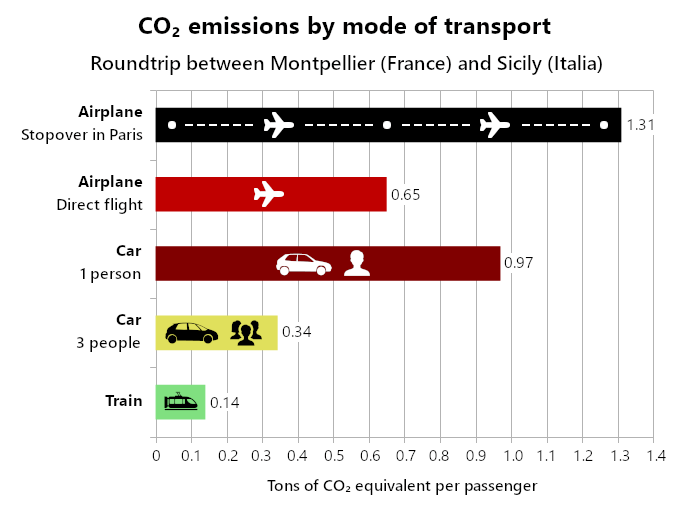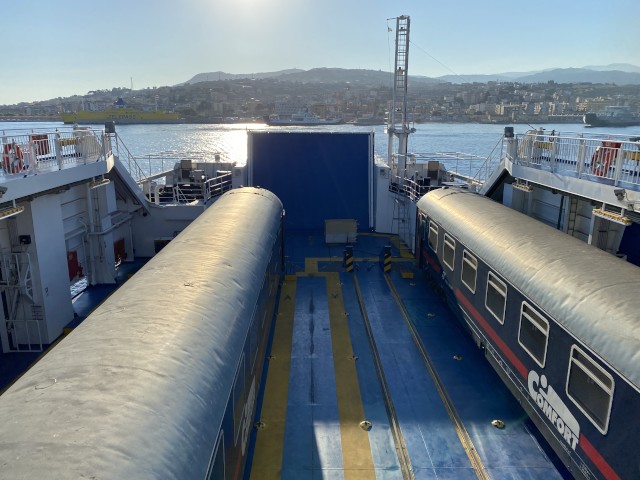Why I traveled to Sicily by train (from France)
Posted on December 29, 2023, by Sébastien
———
I’m not much of a traveler, but I was invited to a wedding in Sicily in 2022.
I live in Montpellier, France, which is roughly 1,000 km (620 mi) away from Sicily in a straight line.
Said straight line involves crossing part of the Mediterranean sea.
Most people wouldn’t think twice about it, and would just purchase the cheapest airplane tickets that get them from point A to point B.
I didn’t. I went by train.
The reason is simple:
Airplane travel has an unacceptable environmental cost.
A matter of carbon footprint

To put the estimates above into perspective, remember that the objective is – roughly – to get everyone’s carbon footprint below 2 tons of CO₂ equivalent per year, by 2050, to keep the global temperature within +2°C above pre-industrial temperatures.
I’ve estimated my own carbon footprint at around 4 tons of CO₂eq/year, using the following simulator:
Clearly, it’s still too much, but it already requires very significant efforts to get there.
By comparison, the average carbon footprint of French people is at least 9 tons of CO₂eq/year per person (including imported emissions), and the per capita carbon footprint of the United-States is twice as high (around 18 tons of CO₂eq in 2018, again, including imported emissions).
It means we’re all over budget (carbon budget) – all of us living in so-called developed countries, at least – and we all need to do everything we can to keep our greenhouse gas emissions in check.
I used the carbon calculator from the GoodPlanet Foundation to estimate the emissions for each mode of transport.
Airplane with a stopover in Paris
There’s an airport in Montpellier (MPL). However, it doesn’t offer direct flights to Sicily.
One way to get there is to take a first flight to Paris Charles de Gaulle (CDG), and then another from Paris to Palermo (PMO), or Catania (CTA).
From Montpellier, Paris is almost in the opposite direction to Sicily, so that makes a lot of unnecessary distance.
Unfortunately, it’s not the worst I’ve seen. Some airlines suggest a trip with 2 stopovers: one in Amsterdam (!) and another in Rome or Milan.
For this simulation, I assumed that all travel between cities in Sicily would be train travel (Palermo, Messina, Catania, Syracuse).
As you can see from the chart above, air travel with stopovers is the worst from a carbon footprint standpoint, with 1.31 tons of CO₂ equivalent for 1 stopover in Paris.
This value includes the impact of condensation trails.
Airplane: direct flight
The nearest airport offering direct flights to Sicily is Marseille (MRS).
This simulation involves going to the Marseille Provence airport by train – the trip takes less than 2 hours – and also travelling between cities in Sicily by train.
From Marseille, there are sometimes direct flights to Palermo (roughly 884 km / 549 mi) or Catania (about 1,064 km / 661 mi).
I used Catania for these estimates.
Compared to the previous option, the emissions are halved (0.65 tons of CO₂eq), but they’re still significant.
This is both the fastest way to reach the destination – the flight takes less than 2 hours – and, unfortunately, the cheapest.
People have no financial incentive to resort to modes of transportation with a lower carbon intensity, and that’s in part due to the fact that commercial aviation fuel is currently tax exempt.
Car: 1 person
To be honest, this one was purely theoretical, as I never seriously considered driving for over 4,000 km (roughly 2,500 miles, roundtrip), alone, and mostly in a foreign country.
Going from Montpellier to Palermo involves over 20 hours of driving – excluding breaks, and sleeping.
Still, it’s interesting to note that it results in a worse carbon footprint than a direct flight, at 0.97 tons of CO₂.
I would have used a small gasoline car for all trips (no train in this scenario).
Car: 3 people
This one wasn’t very realistic either, and would have made sense only if the car was used to visit multiple places in Italy along the way.
Except, a (less than) 2 week vacation is certainly not enough to visit all of Italy.
In fact, we didn’t even have time to visit all of Sicily.
This scenario would have involved going to Grenoble by train, first, thus saving a few hundred kilometers of driving (and some CO₂).
From there, I would have hit the road with my parents, using a bigger, diesel-powered car (a bit more CO₂ per kilometer).
Even though the total carbon footprint is slightly higher than in the previous scenario, it gets divided by 3, to compute the per passenger emissions (0.34 tons of CO₂).
Train
Going from Montpellier to Palermo basically requires spending about 24 hours on board of a train (over 2,000 km, almost 1,300 mi).
Accounting for connections, the trip takes even more than 24 hours.
Fortunately, the train from Rome to Palermo is a night train, so you can sleep on board.
Wait, isn’t Sicily an Island?
Yes, and there’s no bridge, and no tunnel between mainland Italy and Sicily.
Instead, the train cars are loaded onto a ferry in Villa San Giovanni (Calabria), and unloaded on the other side, in Messina (Sicily) after a 20 minute trip (roughly 8 kilometers).

From there, part of the train goes to Palermo, while the rest heads towards Syracuse.
The calculator gives a value of 0.14 tons of CO₂eq.
It might be slightly underestimated, because night trains typically carry less passengers than regular trains, and because it doesn’t account for the (very short) ferry crossing.
It’s also not tailored to the carbon intensity of the Italian grid, and uses a European average.
In any case, I expect the carbon footprint to be below 200 kg of CO₂eq, which makes the train the best option, hands down.
Impact of infrastructure
Obviously, travelling by train requires an entire rail network, whereas an airplane trip only requires 2 airports: one at the starting location, and another one at the destination.
Therefore, one might wonder whether the impact of infrastructure construction changes the outcome.
In fact, it doesn’t change the hierarchy of transport modes.
According to Carbone 4, a consultancy firm, even when accounting for the impact of the vehicle and infrastructure construction, the carbon intensity of the French TGV (high speed train) is roughly 25 times lower than for a short-haul aircraft, or a (non-electric) car – when driving solo.
From the link above, checkout the chart in point 12 (“Is it better to travel by plane or by car, even alone?”).
Not studied: the ferry
There’s currently no ferry service between France and Sicily.
Apparently, there was one in 2019, from Toulon to Trapani, but it didn’t last.
It’s possible to go from Genoa (Italy) to Palermo (roughly 800 km / 500 mi) in about 21 hours.
It’s very difficult to find reliable estimates of the carbon footprint of ferry trips.
Moreover, they vary widely depending on whether you take a car with you, whether you use a cabin and/or any other on board services (restaurant, etc).
However, even the most optimistic estimate from the following simulator (in French) fares worse than a train trip:
And that’s assuming you are not boarding with your car, not using a cabin (not ideal for a 21 hour trip…), nor using the other services such as the restaurant.
A more realistic estimate (3 people in a cabin + restaurant) brings the carbon footprint to a worse value than a direct flight…
Again, the numbers from the simulator need to be taken with a grain of salt, but still, it doesn’t look good for the ferry.
Conclusion
Clearly, train travel was the preferable option, from a carbon footprint perspective.
I’ve actually never been on an airplane, and I don’t intend to change that.
I was shocked to learn that only 15 to 20% of French people have never traveled by air. What a bunch of privileged people are we, seriously?
On a global scale, the situation is reversed, with about 80% of people who have never flown.